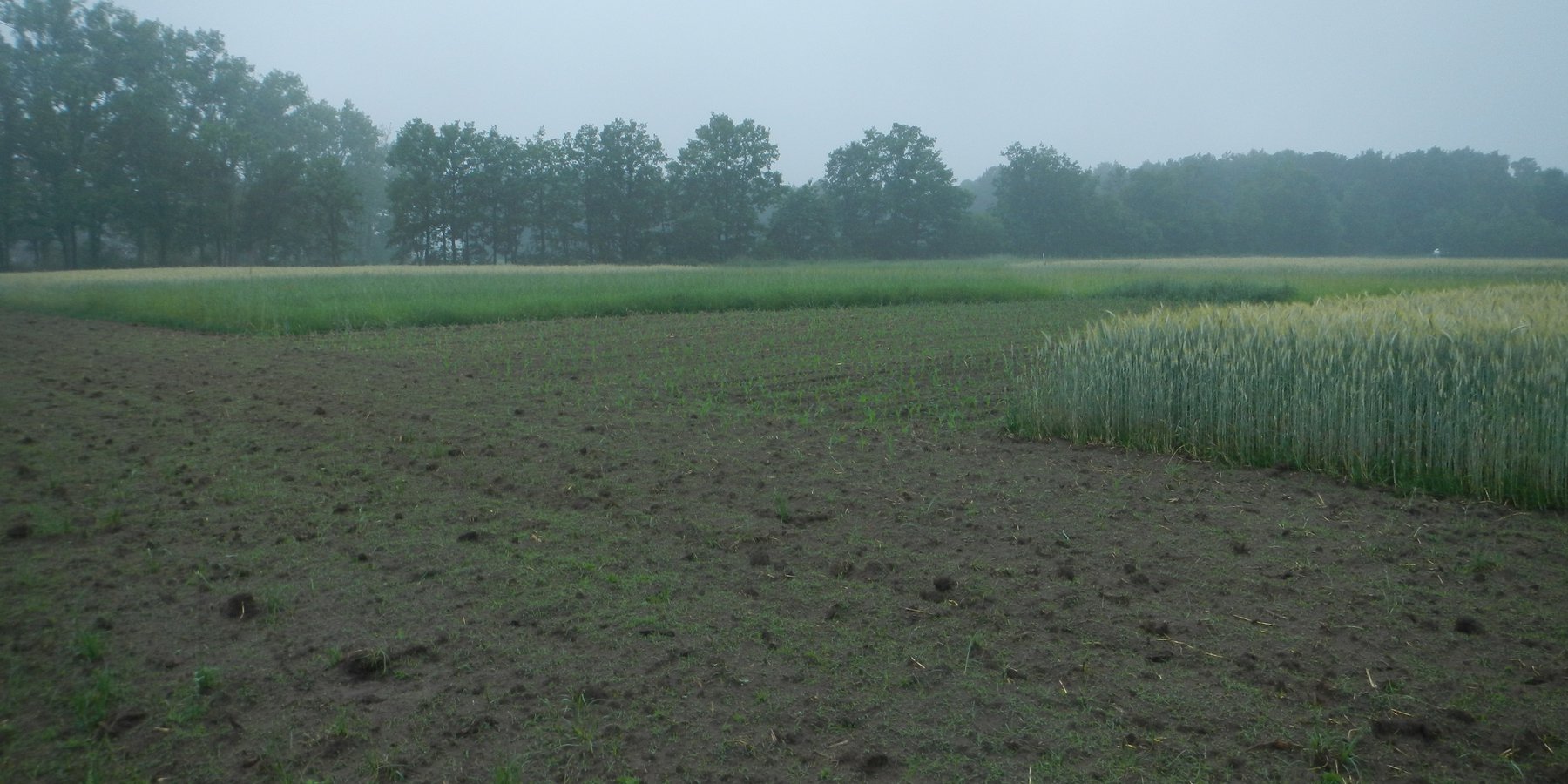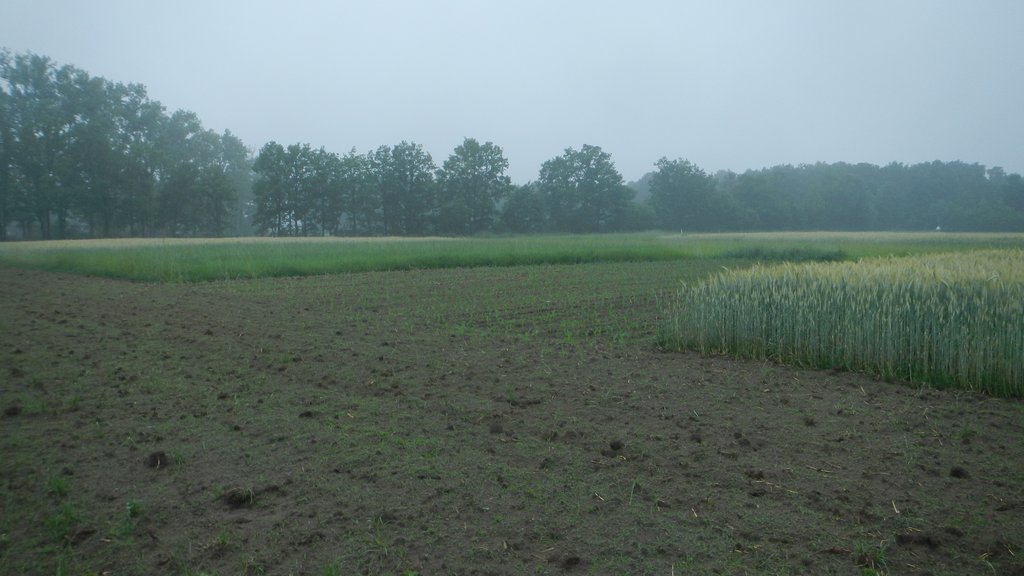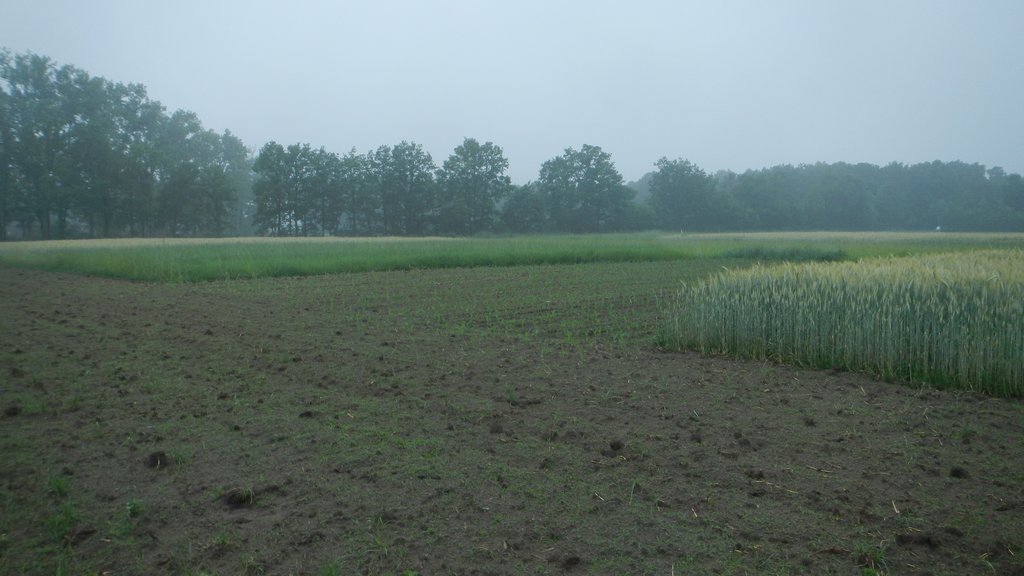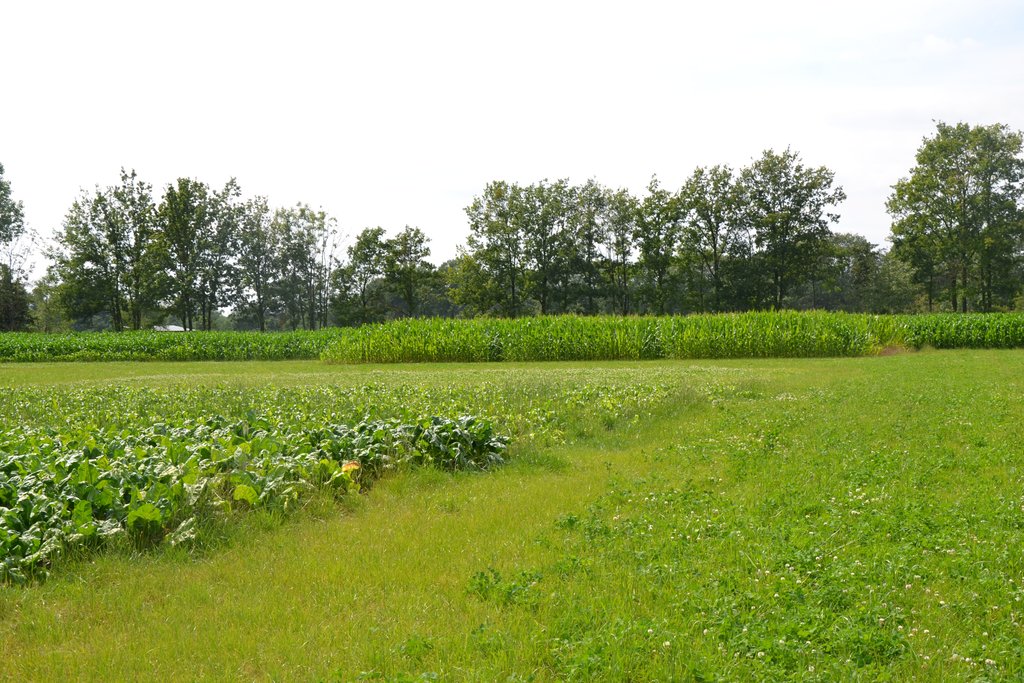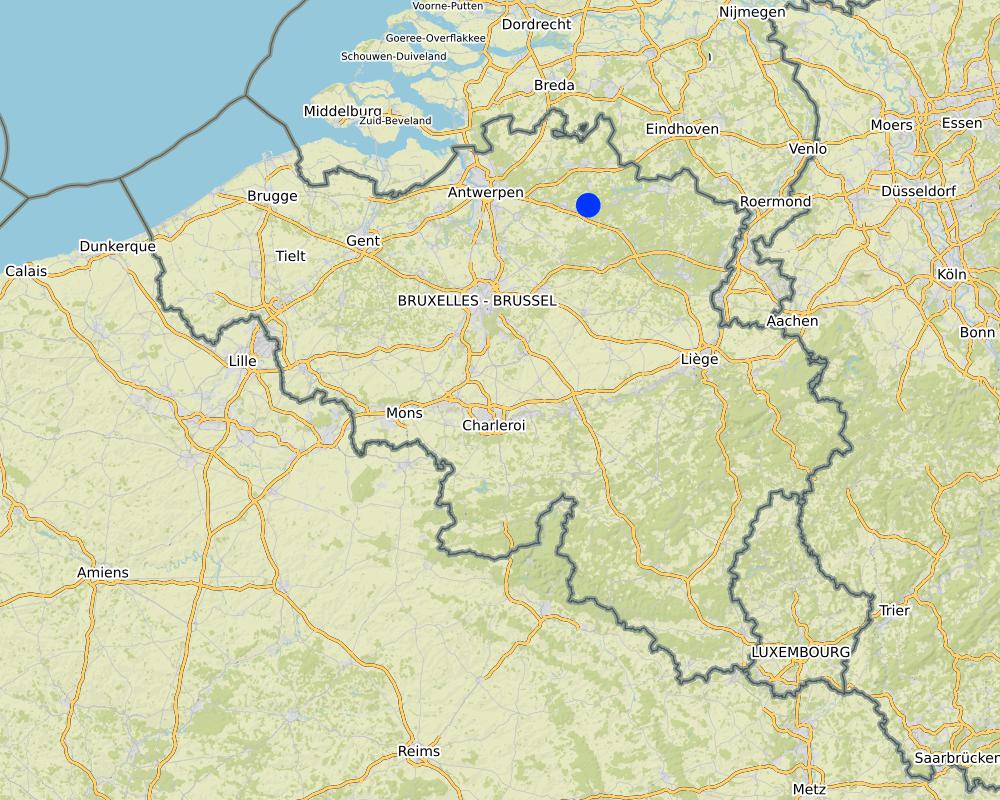Crop rotation [Belgium]
- Creation:
- Update:
- Compiler: Sabine Reinsch
- Editors: David Robinson, Lindsay Maskell
- Reviewers: Renate Fleiner, Rima Mekdaschi Studer
vruchtwisseling / teeltrotatie
technologies_5578 - Belgium
View sections
Expand all Collapse all1. General information
1.2 Contact details of resource persons and institutions involved in the assessment and documentation of the Technology
Key resource person(s)
SLM specialist:
Van de Ven Gert
Hooibeekhoeve
Belgium
Name of project which facilitated the documentation/ evaluation of the Technology (if relevant)
European Interreg project FABulous FarmersName of the institution(s) which facilitated the documentation/ evaluation of the Technology (if relevant)
UK Centre for Ecology & Hydrology (CEH) - United Kingdom1.3 Conditions regarding the use of data documented through WOCAT
The compiler and key resource person(s) accept the conditions regarding the use of data documented through WOCAT:
Ja
1.4 Declaration on sustainability of the described Technology
Is the Technology described here problematic with regard to land degradation, so that it cannot be declared a sustainable land management technology?
Nee
2. Description of the SLM Technology
2.1 Short description of the Technology
Definition of the Technology:
The use of crop rotation in dairy farms to provide fodder on a healthy sandy soil
2.2 Detailed description of the Technology
Description:
Belgium has favourable conditions for agriculture: moderate temperatures, evenly distributed precipitation, and a long growing season. Today, ~28 % of the country is under cultivation. Farming engages only 2 % of the total labour force, but it produces sufficient quantities to make Belgium a net food exporter. About 2/3 of the farms are intensively cultivated units of less than 10 hectares (25 acres).
The Functional Agro-Biodiversity (FAB) measure on avoiding monocultures and implementing crop rotations was established on a trial field in Belgium, Geel. The region is characterised by sandy soil and the main crop is maize, mostly in monoculture. Main reasons to stick in the monoculture of maize are the lack of knowledge of the alternatives, specifically on feed value of the crops and storage of the harvested product.
In this trial field different crops are placed in small fields (18 x 25 m) next to each other. The crops are always chosen to be part of the fodder for the dairy cattle. The different root types ensure a better soil structure. The diversity in plants make the field less susceptible for diseases and weeds and give a better uptake of the nutrients that are available in the soil. After one year, we already saw a 50% reduction in weeds compared to the monoculture maize.
The soil is less degraded and even soil carbon sequestration is possible. The latter is not only beneficial for climate regulation but also provides a spongy soil which can capture the water more easily, but also stores the water and makes it available to plants in drier periods. This makes the land more resilient to extreme weather conditions. The difference in sowing time and harvesting time give a higher range in choice for the type of cover crops and give less chance for weeds to develop in the same way year after year. In the reference year 2017 (maize in all the fields), we already saw an additional yield of 10% where crop rotation had been implemented.
The compilation of this SLM is a part of the European Interreg project FABulous Farmers which aims to reduce the reliance on external inputs by encouraging the use of methods and interventions that increase the farm’s Functional AgroBiodiversity (FAB). Visit www.fabulousfarmers.eu and www.nweurope.eu/Fabulous-Farmers for more information.
2.3 Photos of the Technology
2.5 Country/ region/ locations where the Technology has been applied and which are covered by this assessment
Country:
Belgium
Region/ State/ Province:
Antwerpen
Further specification of location:
Geel
Specify the spread of the Technology:
- applied at specific points/ concentrated on a small area
Is/are the technology site(s) located in a permanently protected area?
Nee
Comments:
Latitude 51.225145
Longitude 5.025308
Map
×2.6 Date of implementation
Indicate year of implementation:
2016
2.7 Introduction of the Technology
Specify how the Technology was introduced:
- during experiments/ research
3. Classification of the SLM Technology
3.1 Main purpose(s) of the Technology
- improve production
- reduce, prevent, restore land degradation
- adapt to climate change/ extremes and its impacts
3.2 Current land use type(s) where the Technology is applied
Land use mixed within the same land unit:
Nee

Cropland
- Annual cropping
Annual cropping - Specify crops:
- cereals - barley
- cereals - maize
- cereals - sorghum
- cereals - wheat (spring)
- fodder crops - clover
Number of growing seasons per year:
- 1
Is intercropping practiced?
Nee
Is crop rotation practiced?
Ja
If yes, specify:
5 experimental fields:
Field 1: 2016: maize + cover crop, 2017: maize + cover crop, 2018: maize + cover crop, 2019: maize + cover crop
Field 2: 2016: grass clover, 2017: maize + grass, 2018: grass clover, 2019: grass clover
Field 3: 2016: spring barley + cover crop, 2017: maize + wheat (saw), 2018: wheat + grass, 2019: grass clover
Field 4: 2016: spring barley + grass, 2017: 1 cut grass + maize + wheat (saw), 2018: wheat + grass, 2019: 1 cut grass + sorghum
Field 5: 2016: fodder beet, 2017: maize + wheat (saw), 2018: wheat + cover crops, 2019: fodder beet
Plan for all fields is to plant maize in 2020.
3.3 Has land use changed due to the implementation of the Technology?
Has land use changed due to the implementation of the Technology?
- No (Continue with question 3.4)
Land use mixed within the same land unit:
Nee
3.4 Water supply
Water supply for the land on which the Technology is applied:
- rainfed
3.5 SLM group to which the Technology belongs
- rotational systems (crop rotation, fallows, shifting cultivation)
3.6 SLM measures comprising the Technology

agronomic measures
- A1: Vegetation/ soil cover
3.7 Main types of land degradation addressed by the Technology

chemical soil deterioration
- Cn: fertility decline and reduced organic matter content (not caused by erosion)
3.8 Prevention, reduction, or restoration of land degradation
Specify the goal of the Technology with regard to land degradation:
- prevent land degradation
- reduce land degradation
4. Technical specifications, implementation activities, inputs, and costs
4.1 Technical drawing of the Technology
Technical specifications (related to technical drawing):
The crop rotation field trial is set-up in two replicates. 5 fields per replicate are planted with a mixture of crops (bottom table). The crop rotation in 2019 is illustrated exemplary. Previous crop rotations on each field (field numbers 1 to 5) are detailed in the table. For 2020, a maize monoculture is planned to assess the impact of crop rotation trials on yields and ecosystem services.
Author:
Katrien Geudens
Date:
01/09/2019
4.2 General information regarding the calculation of inputs and costs
Specify how costs and inputs were calculated:
- per Technology area
other/ national currency (specify):
€
If relevant, indicate exchange rate from USD to local currency (e.g. 1 USD = 79.9 Brazilian Real): 1 USD =:
0.91
4.4 Costs and inputs needed for establishment
| Specify input | Unit | Quantity | Costs per Unit | Total costs per input | % of costs borne by land users | |
|---|---|---|---|---|---|---|
| Other | Estimate of all-inclusive costs for a 4 yr rotation (workforce/equipment/material) | ha/4yrs | 1.0 | 2000.0 | 2000.0 | 100.0 |
| Total costs for establishment of the Technology | 2000.0 | |||||
| Total costs for establishment of the Technology in USD | 2197.8 | |||||
If land user bore less than 100% of costs, indicate who covered the remaining costs:
NA
Comments:
Here you can find an overview of costs for a range of crop rotations. To compare them in a proper way, we also added the price in combination with the milk yield (€/1000 kVEMeq) and this split up for sand and sandy loam.
Crop rotation: maize - leguminous crop - fodder beet - triticale: 1926 €/ha; Sandy soil: 120 €/1000 kVEMeg; Sandy Loam: 108 €/1000 kVEMeq
Crop rotation: maize - winter triticale - fodder beet: 2066 €/ha, Sandy soil: 127 €/1000 kVEMeg; Sandy Loam: 114 €/1000 kVEMeg
Crop rotation: grass clover - fodder beet - maize - winter triticale: 2090€/ha, Sandy soil: 148€/1000 kVEMeg; Sandy Loam: 133 €/1000 kVEMeg
Crop rotation: grass clover - potato - maize winter triticale: 1980 €/ha, Sandy soil: 140€/1000 kVEMeg; Sandy Loam: 126€/1000 kVEMeg
Crop rotation: grass clover - maize - winter triticale: 1944 €/ha, Sandy soil: 148 €/1000 kVEMeg; Sandy Loam: 133 €/1000 kVEMeg
Monoculture maize + grass cover crop + grass clover meadow (no derogation): 2080 €/ha, Sandy soil: 156 €/1000 kVEMeg; Sandy Loam: 140 €/1000 kVEMeg
Monoculture maize + grass clover meadow, 1 cut (derogation): 2304 €/ha, Sandy soil: 167€/1000 kVEMeg; Sandy Loam: 150 €/1000 kVEMeg
Monoculture maize + grass clover meadow (no derogation): 2048 €/ha, Sandy soil: 160 €/1000 kVEMeg; Sandy Loam: 144 €/1000 kVEMeg
(Source: http://www.lcvvzw.be/publicaties/ A2018_6 Scenariofiches vruchtwisseling)
5. Natural and human environment
5.1 Climate
Annual rainfall
- < 250 mm
- 251-500 mm
- 501-750 mm
- 751-1,000 mm
- 1,001-1,500 mm
- 1,501-2,000 mm
- 2,001-3,000 mm
- 3,001-4,000 mm
- > 4,000 mm
Agro-climatic zone
- sub-humid
5.2 Topography
Slopes on average:
- flat (0-2%)
- gentle (3-5%)
- moderate (6-10%)
- rolling (11-15%)
- hilly (16-30%)
- steep (31-60%)
- very steep (>60%)
Landforms:
- plateau/plains
- ridges
- mountain slopes
- hill slopes
- footslopes
- valley floors
Altitudinal zone:
- 0-100 m a.s.l.
- 101-500 m a.s.l.
- 501-1,000 m a.s.l.
- 1,001-1,500 m a.s.l.
- 1,501-2,000 m a.s.l.
- 2,001-2,500 m a.s.l.
- 2,501-3,000 m a.s.l.
- 3,001-4,000 m a.s.l.
- > 4,000 m a.s.l.
Indicate if the Technology is specifically applied in:
- not relevant
5.3 Soils
Soil depth on average:
- very shallow (0-20 cm)
- shallow (21-50 cm)
- moderately deep (51-80 cm)
- deep (81-120 cm)
- very deep (> 120 cm)
Soil texture (topsoil):
- coarse/ light (sandy)
Soil texture (> 20 cm below surface):
- coarse/ light (sandy)
Topsoil organic matter:
- medium (1-3%)
If available, attach full soil description or specify the available information, e.g. soil type, soil PH/ acidity, Cation Exchange Capacity, nitrogen, salinity etc.
From 50 cm the soil is white sand.
5.4 Water availability and quality
Ground water table:
< 5 m
Availability of surface water:
good
Water quality (untreated):
poor drinking water (treatment required)
Water quality refers to:
both ground and surface water
Is water salinity a problem?
Nee
Is flooding of the area occurring?
Nee
5.5 Biodiversity
Species diversity:
- medium
Habitat diversity:
- high
5.6 Characteristics of land users applying the Technology
Sedentary or nomadic:
- Sedentary
Market orientation of production system:
- subsistence (self-supply)
Relative level of wealth:
- average
Individuals or groups:
- employee (company, government)
Level of mechanization:
- mechanized/ motorized
Gender:
- men
Age of land users:
- middle-aged
Indicate other relevant characteristics of the land users:
Market orientation: subsistence: the fodder crops are for own use, the milk is sold.
5.7 Average area of land used by land users applying the Technology
- < 0.5 ha
- 0.5-1 ha
- 1-2 ha
- 2-5 ha
- 5-15 ha
- 15-50 ha
- 50-100 ha
- 100-500 ha
- 500-1,000 ha
- 1,000-10,000 ha
- > 10,000 ha
Is this considered small-, medium- or large-scale (referring to local context)?
- medium-scale
5.8 Land ownership, land use rights, and water use rights
Land ownership:
- state
Land use rights:
- individual
- No access to water on the field (normally not necessary).
Are land use rights based on a traditional legal system?
Nee
5.9 Access to services and infrastructure
health:
- poor
- moderate
- good
education:
- poor
- moderate
- good
technical assistance:
- poor
- moderate
- good
employment (e.g. off-farm):
- poor
- moderate
- good
markets:
- poor
- moderate
- good
energy:
- poor
- moderate
- good
roads and transport:
- poor
- moderate
- good
drinking water and sanitation:
- poor
- moderate
- good
financial services:
- poor
- moderate
- good
6. Impacts and concluding statements
6.1 On-site impacts the Technology has shown
Socio-economic impacts
Production
crop production
crop quality
fodder production
fodder quality
product diversity
land management
Income and costs
workload
Socio-cultural impacts
food security/ self-sufficiency
Ecological impacts
Soil
soil moisture
soil cover
soil compaction
nutrient cycling/ recharge
soil organic matter/ below ground C
Biodiversity: vegetation, animals
Vegetation cover
plant diversity
beneficial species
habitat diversity
pest/ disease control
Comments/ specify:
The crops are less susceptible to pests. The damage caused (loss of yield) is less than the cost of protection.
Climate and disaster risk reduction
drought impacts
6.2 Off-site impacts the Technology has shown
buffering/ filtering capacity
6.3 Exposure and sensitivity of the Technology to gradual climate change and climate-related extremes/ disasters (as perceived by land users)
Gradual climate change
Gradual climate change
| Season | increase or decrease | How does the Technology cope with it? | |
|---|---|---|---|
| seasonal rainfall | summer | increase | well |
6.4 Cost-benefit analysis
How do the benefits compare with the establishment costs (from land users’ perspective)?
Short-term returns:
slightly negative
Long-term returns:
positive
How do the benefits compare with the maintenance/ recurrent costs (from land users' perspective)?
Short-term returns:
slightly negative
Long-term returns:
positive
6.5 Adoption of the Technology
- 1-10%
Of all those who have adopted the Technology, how many did so spontaneously, i.e. without receiving any material incentives/ payments?
- 91-100%
6.6 Adaptation
Has the Technology been modified recently to adapt to changing conditions?
Nee
6.7 Strengths/ advantages/ opportunities of the Technology
| Strengths/ advantages/ opportunities in the land user’s view |
|---|
| Higher resilience to climate change |
| Higher resilience to plagues and diseases |
| Increased soil carbon stock |
| Increased yields and income |
| Strengths/ advantages/ opportunities in the compiler’s or other key resource person’s view |
|---|
| Increased soil carbon stock |
| Increased food security |
6.8 Weaknesses/ disadvantages/ risks of the Technology and ways of overcoming them
| Weaknesses/ disadvantages/ risks in the land user’s view | How can they be overcome? |
|---|---|
| Feed value of the "new" crop | Analysis of the crops in standardised tables |
| More cultivation training/exercise necessary | Getting better training/knowledge by joining demonstrations or networks, and use available literature |
| Investment costs (other than machinery) |
| Weaknesses/ disadvantages/ risks in the compiler’s or other key resource person’s view | How can they be overcome? |
|---|---|
| More planning time needed for the different crops | Learn from previous years and other farmers experience |
7. References and links
7.1 Methods/ sources of information
- interviews with land users
7.3 Links to relevant online information
Title/ description:
EEN BETERE BODEMVRUCHTBAARHEID BIJ MAÏS DOOR VRUCHTWISSELING
URL:
http://www.lcvvzw.be/wp-content/uploads/2019/07/A2016_5Bodemvruchtbaarheidmais.pdf
Title/ description:
Vruchtwisseling: perspectieven op korte én lange termijn
URL:
https://www.landbouwleven.be/2660/article/2018-03-26/vruchtwisseling-perspectieven-op-korte-en-lange-termijn
Title/ description:
Monocultuur kuilmaïs (geen derogatie)
URL:
http://www.lcvvzw.be/wp-content/uploads/2018/05/A2018_3_Vruchtwisselingsfiches.pdf
Links and modules
Expand all Collapse allLinks
No links
Modules
No modules


